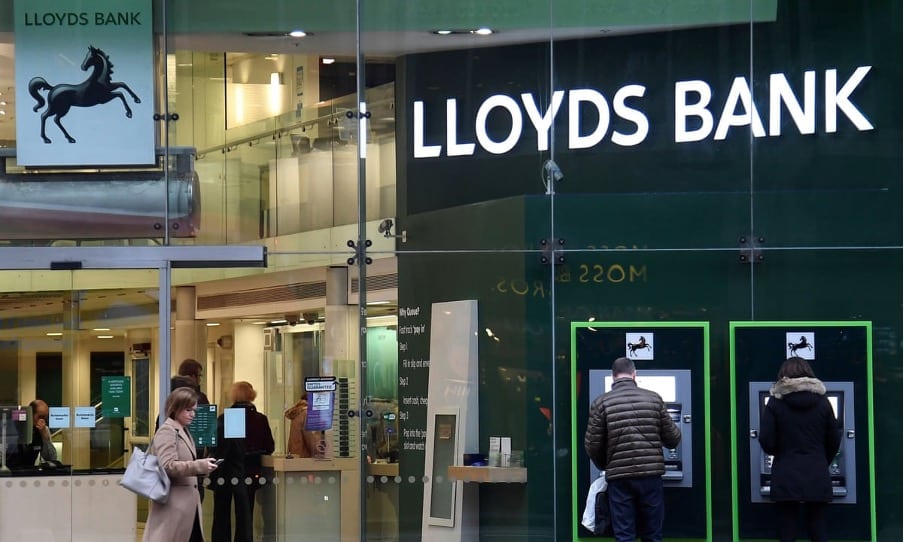Lloyds’ share price has surged by 5% today after beating quarterly profit estimates and positively updating full-year guidance.
Despite the broadly positive news, Lloyds’ (LON: LLOY) shares now stand at 45.39p, down 9% year-to-date, and roughly a third lower than pre-pandemic levels.
However, a Reuters Refinitiv poll of top analysts yesterday came up with four strong buys, 12 buys, five holds, and just three sells, with a median price target of 60p.
And with 30 million customers across its brand portfolio, the UK’s bellwether bank is looking increasingly oversold.
Lloyds share price: half-year results
With recession in the air and consumer spending down, analyst consensus was for Q2 profits of £1.6 billion derived from revenue of £4.1 billion.
However, the FTSE 100 bank solidly beat expectations, delivering pre-tax profits of £2.04 billion, narrowly above the £2.01 billion it made in the same quarter last year, while revenue rose by 10% year-over-year to £4.3 billion. Across the first half, underlying profits rose by 34% to £4.1 billion.

Lloyds did have to set aside a £200 million impairment charge to account for potential bad loans. Just a year ago, it released £374 million which had been set aside for pandemic-era lending, an awkward reminder that the bank is not out of the woods yet.
£95 million of its new impairment charge was put down to the weaker economic background in the UK, with the country set for the lowest growth of G7 members in 2023 according to the International Monetary Fund.
On the plus side, the FTSE 100 bank has raised its full-year forecast, increasing its net interest margin projection (what it earns from lending minus what it pays for deposits) by 10 basis points to 280 basis points. And it expects return on tangible equity — a key banking metric — to be around 13%, a full 2 percentage points higher than previous estimates.
These predictions are predominantly based on the increasing base rate, which now stands at 1.25%. Bank of England governor Andrew Bailey has warned a further 50 basis points rise remains ‘on the table’ in August, while Capital Economics predicts it could hit 3% by 2023.
As the UK’s largest home lender, Lloyds’ open mortgage book has increased by 2% over the past year to £296.6 billion. In total, loans and advances to customers increased by £7.5 billion in H1 to £456.1 billion
The bank announced an interim ordinary dividend of 0.80p a share, up 20% on 2021.
Where next for Lloyds shares?
With dire predictions of recession, both in the UK and globally, Lloyds’ investors are becoming increasingly concerned that the downturn could wipe out any additional profits. With most having less than £500 of personal savings with Lloyds, CEO Charlie Nunn has personally encouraged customers in difficulty to contact the bank.
However, it hasn’t yet seen any major problems with its customers, despite increasing mortgage costs and CPI inflation at a decades-high 9.4%.
But Nunn has warned that problems could still apparate, with inflation set to exceed 11% in October as energy bills skyrocket. The CEO warns ‘the persistency and potential impact of higher inflation remains a source of uncertainty for the UK economy as many consumers grapple with cost-of-living pressures.’
Discretionary spending is tanking, with spending of white goods down, and 2.2 million non-essential subscriptions cancelled in the past year.
Of course, with 74% of UK mortgagees on fixed rates, including the overwhelming majority of equity-poor first-time buyers, it could take years for the financial pressures to fully materialise.

By far the largest risk to Lloyds comes from the volatile housing market. Rightmove research shows the average asking price for a UK home now stands at a record £369,968 in July. And according to Lloyds’ subsidiary Halifax, the market is starting to slow down.
Moreover, the FTSE 100 bank has doubled down on its housing market bet, snapping up Kensington Mortgages for £2.3 billion. And it’s creating a £4 billion portfolio of 50,000 rental homes through its Citra Living venture over the next decade, making it by far the largest landlord in the UK.
More widely, Lloyds has launched a £4 billion strategy to grow its wealth management and investment divisions after years of losing market share. The ambitious plan could see its share price recover to previous heights but will likely lead to more volatility.
Nunn enthuses ‘in February we announced an ambitious strategy to transform our business…we remain well placed to withstand the current macroeconomic uncertainty and continue to generate significant capital for our shareholders.’
The numbers do back him up. Customer deposits rose by £1.9 billion to £478.2 billion in the half, and Lloyds now boasts a loan to deposit ratio of 95%, continuing to ‘provide robust funding and liquidity and potential for growth.’
Further, the bank has a CET1 ratio of 14.7%, above its own 12.5% target, and far in excess of the 4.5% target demanded by the FCA under UK monetary law.
This leaves Lloyds shares seemingly oversold, with just one housing sized risk to consider.
